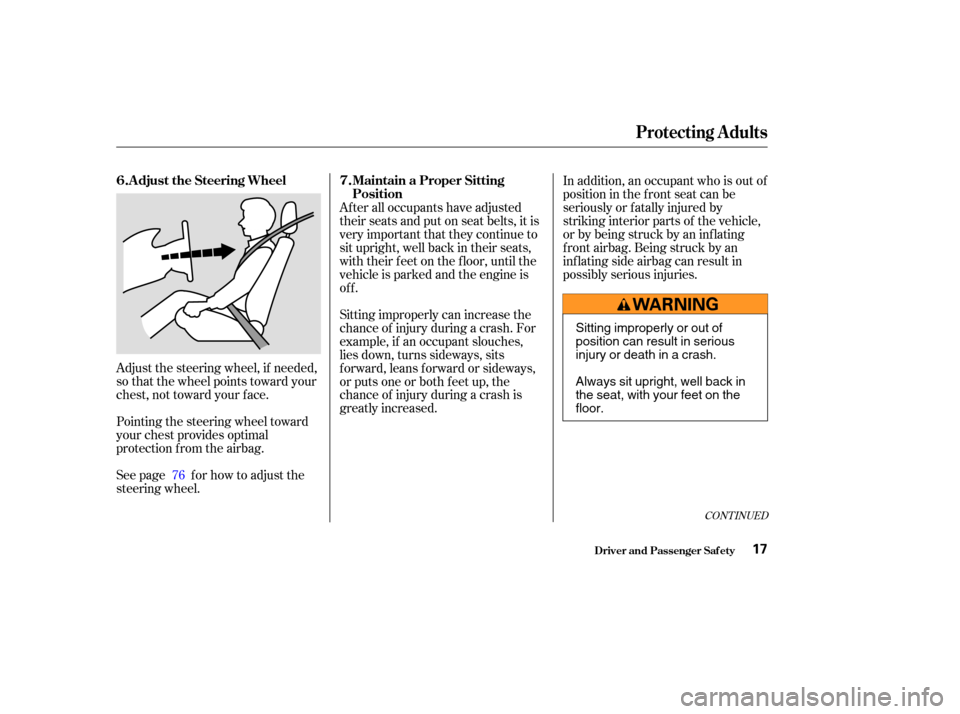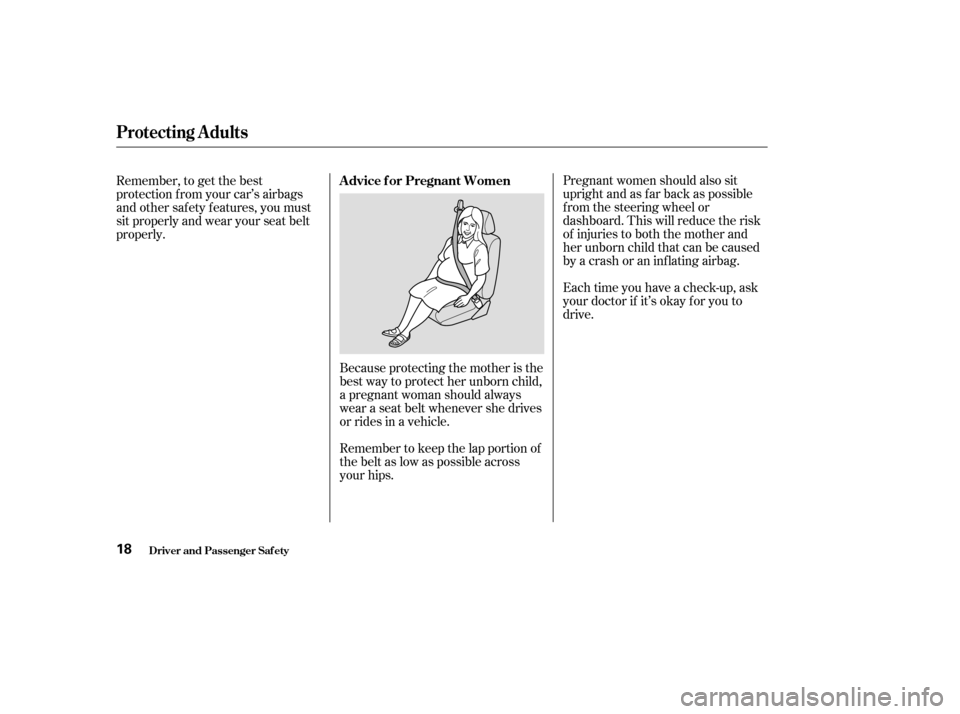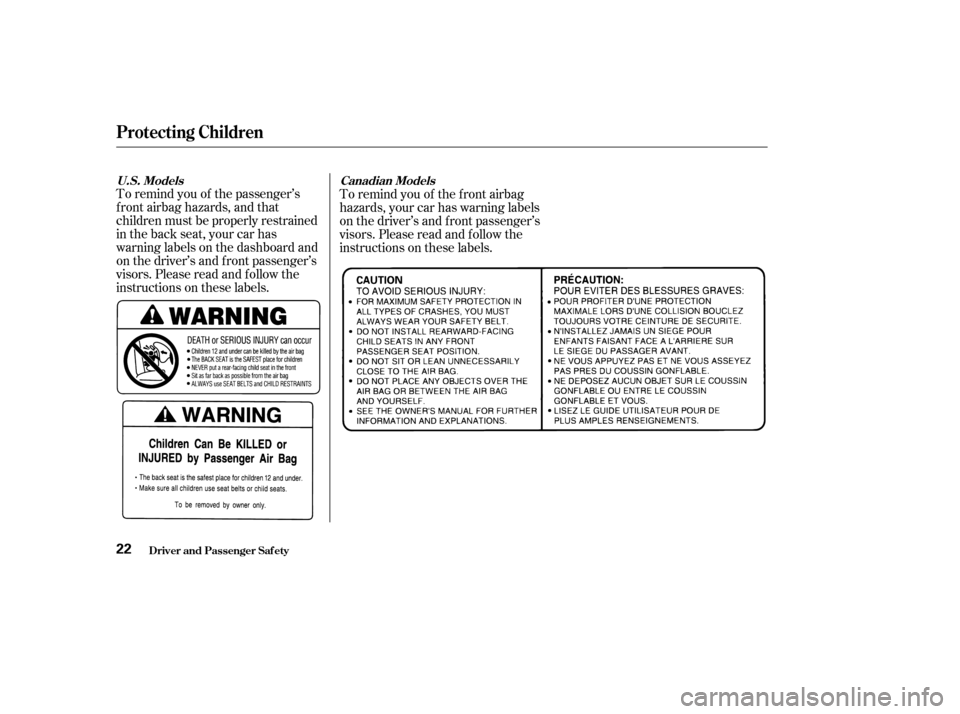airbag Acura RL 2004 3.5 User Guide
[x] Cancel search | Manufacturer: ACURA, Model Year: 2004, Model line: RL, Model: Acura RL 2004Pages: 370, PDF Size: 4.33 MB
Page 20 of 370

Adjust the steering wheel, if needed,
so that the wheel points toward your
chest, not toward your f ace.
See page f or how to adjust the
steering wheel. Pointing the steering wheel toward
your chest provides optimal
protection f rom the airbag.In addition, an occupant who is out of
position in the f ront seat can be
seriously or f atally injured by
striking interior parts of the vehicle,
or by being struck by an inf lating
f ront airbag. Being struck by an
inf lating side airbag can result in
possibly serious injuries.
After all occupants have adjusted
their seats and put on seat belts, it is
very important that they continue to
sit upright, well back in their seats,
with their feet on the floor, until the
vehicle is parked and the engine is
off.
Sitting improperly can increase the
chance of injury during a crash. For
example, if an occupant slouches,
lies down, turns sideways, sits
forward, leans forward or sideways,
or puts one or both f eet up, the
chance of injury during a crash is
greatly increased.
76
CONT INUED
Adjust the Steering Wheel Maintain a Proper Sitting
Position
6.
7.
Protecting Adults
Driver and Passenger Saf ety17
Sitting improperly or out of
position can result in serious
injury or death in a crash.
Always sit upright, well back in
the seat, with your feet on the
floor.
Page 21 of 370

Pregnant women should also sit
upright and as f ar back as possible
f rom the steering wheel or
dashboard. This will reduce the risk
of injuries to both the mother and
her unborn child that can be caused
by a crash or an inf lating airbag.
Each time you have a check-up, ask
your doctor if it’s okay f or you to
drive.
Remember to keep the lap portion of
the belt as low as possible across
your hips.
Remember, to get the best
protection f rom your car’s airbags
and other safety features, you must
sit properly and wear your seat belt
properly.
Because protecting the mother is the
best way to protect her unborn child,
a pregnant woman should always
wear a seat belt whenever she drives
or rides in a vehicle. Advice f or Pregnant Women
Protecting Adults
Driver and Passenger Saf ety18
Page 22 of 370

If they do, they
could be very seriously injured in a
crash. Carrying hard or sharp
objects on your lap, or driving with
a pipe or other sharp objects in
your mouth, can result in injuries
if your f ront airbag inf lates.
If your
hands or arms are close to the
airbag cover in the center of the
steering wheel or on top of the
dashboard, they could be injured if
the front airbag inflates.
Devices intended to improve
occupant comf ort or reposition the
shoulder part of a seat belt can
severely compromise the
protective capability of the seat
belt and increase the chance of
serious injury in a crash. If a side airbag
inflates,acupholderorotherhard
object attached on or near the
door could be propelled inside the
vehicle and hurt someone.
Any object
attached to or placed on the covers
marked ‘‘SRS AIRBAG’’ in the
center of the steering wheel and
on top of the dashboard could
interf ere with the proper operation
of the airbags. Or, if the airbags
inf late, the objects could be
propelled inside the vehicle and
hurt someone.
Additional Saf ety Precautions
T wo people should never use t he
same seat belt . Do not place hard or sharp object s
bet ween yourself and a f rontairbag.
K eep your hands and arms awayf rom t he airbag covers.
Do not put any accessories on seat
belts. Do not at t ach hard object s on or
near a f ront door.
Do not at t ach or place object s on the f ront airbag covers.
Protecting Adults
Driver and Passenger Saf ety19
Page 24 of 370

According to accident statistics,
children of all ages and sizes are
saf er when they are restrained in the
back seat, not the f ront seat. The
National Highway Traf f ic Saf ety
Administration and Transport
Canada recommend that all children
ages 12 and under be properly
restrained in the back seat.
In the back seat, children are less
likely to be injured by striking hard
interior parts during a collision or
hard braking. Also, children cannot
be injured by an inf lating airbag
when they ride in the back.Front airbags have been designed to
help protect adults in a moderate to
severe f rontal collision. To do this,
the passenger’s f ront airbag is quite
large, and it inf lates with tremendous
speed.
Whenever possible,
larger children should sit in the back
seat, in a booster seat if needed, and
be properly restrained with a seat
belt. (See page f or important
inf ormation about protecting larger
children.)
If
the airbag inf lates, it can hit the back
of the child seat with enough force
to kill or very seriously injure an
inf ant. If the vehicle seat is
too far forward, or the child’s head is
thrown f orward during a collision, an
inflating front airbag can strike the
child with enough f orce to kill or
very seriously injure a small child.
35
CONT INUED
Small Children
Larger Children
Inf ant s
Children who have outgrown childseat s are also at risk of being injuredor killed by an inf lat ing passenger’sfront airbag.
Never put a rear-f acing child seat in
t he f ront seat of a vehicle equippedwit h a passenger’s f ront airbag. Placing a f orward-f acing child seat in
t he f ront seat of a vehicle equippedwit h a passenger’s f ront airbag canbe hazardous.Children Should Sit in the Back
Seat The Passenger’s Front Airbag
Poses Serious Risks to Children
Protecting Children
Driver and Passenger Saf ety21
Page 25 of 370

To remind you of the passenger’s
f ront airbag hazards, and that
children must be properly restrained
in the back seat, your car has
warninglabelsonthedashboardand
on the driver’s and f ront passenger’s
visors. Please read and f ollow the
instructions on these labels.To remind you of the f ront airbag
hazards, your car has warning labels
on the driver’s and f ront passenger’s
visors. Please read and f ollow the
instructions on these labels.
U.S. Models
Canadian Models
Protecting Children
Driver and Passenger Saf ety22
Page 26 of 370

Using this f eature will
prevent children f rom opening the
doors and accidentally f alling out
(see page ).
Using
this f eature will prevent children
f rom playing with the windows,
which could expose them to
hazards or distract the driver (see
page ).
Many parents say they pref er to put
an inf ant or small child in the f ront
passenger seat so they can watch the
child, or because the child requires
attention.
Placing a child in the f ront seat
exposes the child to hazards f rom
the passenger’s f ront airbag, and
paying close attention to a child
distracts the driver f rom the
important tasks of driving, placing
both of you at risk.
If a child requires physical attention
or f requent visual contact, we
strongly recommend that another
adult ride with the child in the back
seat. The back seat is far safer for a
child than the front.
Place the largest child in the f ront
seat, provided the child is large
enough to wear a seat belt
properly (see page ).
Move the vehicle seat as far to the
rear as possible (see page ).
Have the child sit upright and well
backintheseat(seepage ).
Make sure the seat belt is properly
positioned and secured (see page
).
Your car has three seating positions
in the back seat where children can
be properly restrained.
If you ever have to carry more than
three children in your car:
1217
15 10487
35
CONT INUED
Additional Saf ety Precautions
If a Child Requires Close
Attention
If You Must Drive with Several
Children
Use childproof door locks t o
prevent children f rom opening t hedoors.
Use t he main power windowswit ch t o prevent children f romopening t he rear windows.
Protecting Children
Driver and Passenger Saf ety23
Page 29 of 370

If a small child must ride in the
f ront, f ollow the instructions
provided in this section.
This page brief ly summarizes Acura’s
recommendations on where to place
rear-f acing and f orward-f acing child
seats in your car.
The passenger’s f ront airbag
inf lates with enough f orce to kill
or seriously injure an inf ant in a
rear-facing child seat. Never in the f ront seat, due
to the f ront airbag hazard.
Recommended positions.
Properlysecurearear-facingchild
seat (see page ).
Recommended
positions. Properly secure a
forward-facing child seat (see
page ).
A small child in a f orward-f acing
child seat is also at risk. If the
vehicle seat is too f ar f orward,
or the child’s head is thrown
f orward during a collision, an
inf lating f ront airbag can kill or
seriously injure the child. Not recommended,
due to the f ront airbag hazard. If a
small child must ride in f ront,
move the vehicle seat to the rear-
most position and secure a
forward-facing child seat with the
seat belt (see page ).
32 2832
Placing a Child Seat
Front Passenger’s Seat
Inf ant s:
Back Seat sInf ant s:
Small children:
Small children:
Airbags Pose Serious
Risks to Children
Protecting Children
Driver and Passenger Saf ety26
Page 31 of 370

Only a rear-f acing child seat provides
proper support f or a baby’s head,
neck, and back. Inf ants up to about
one year of age must be restrained in
a rear-f acing child seat.
Two types of seats may be used: a
seat designed exclusively f or inf ants,
or a convertible seat used in the rear-
f acing, reclining mode.If the passenger’s
f ront airbag inf lates, it can hit the
back of the child seat with enough
f orce to kill or seriously injure an
inf ant. If an inf ant must be closely
watched, we recommend that
another adult sit in the back seat
with the baby.
If placed
f acing f orward, an inf ant could be
very seriously injured during a
f rontal collision.
We recommend that an inf ant be
restrained in a rear-f acing child seat
until the inf ant is at least one year
old, reaches the seat maker’s weight
or height limit, and is able to sit up
without support. In this vehicle, a rear-f acing child
seatcanbeplacedinanyseating
position in the back, but not in the
front seat.
Protecting Inf ants
Child Seat T ype Rear-Facing Child Seat Placement
Never put a rear-f acing child seat inthe front seat.
Do not put a rear-f acing child seat ina f orward-f acing position.
Protecting Children
Driver and Passenger Saf ety28
Placing a rear-facing child seat
in the front seat can result in
serious injury or death if the
passenger’s front airbag inflates.
Always place a rear-facing child
seat in the back seat, not the
front.
Page 35 of 370

A child at least one year old who can
sit up without support, and who f its
within the child seat maker’s weight
and height limits, should be
restrained in a f orward-f acing,
upright child seat.
Of the different seats available, we
recommend those that have a f ive-
point harness system as shown.In this vehicle, the best place to
install a f orward-f acing child seat is
in one of the seating positions in the
back seat.
If the vehicle seat is
too far forward, or the child’s head is
thrown f orward during a collision, an
inflating front airbag can strike the
child with enough f orce to cause
very serious or f atal injuries. If a
small child must be closely watched,
we recommend that another adult sit
in the back seat with the child. If it is necessary to put a f orward-
f acing child seat in the f ront, move
the vehicle seat as far to the rear as
possible, be sure the child seat is
f irmly secured to the vehicle, and the
child is properly strapped in the seat.
Protecting Small Children
Child Seat T ype
Child Seat Placement
Placing a f orward-f acing child seat int he f ront seat of a vehicle equippedwit h a passenger’s f ront airbag canbe hazardous.
Protecting Children
Driver and Passenger Saf ety32
Improperly placing a forward-
facing child seat in the front
seat can result in serious injury
or death if the front airbags
inflate.
Ifyoumustplaceaforward-
facing child seat in front, move
the vehicle seat as far back as
possible and properly restrain
the child.
Page 38 of 370

If you are not wearing a seat
belt in a crash, you could be
thrown f orward into the
dashboard and crush the child.
During a crash, the
belt could press deep into the child
and cause very serious injuries. When a child reaches the
recommended weight or height limit
for a forward-facing child seat, the
child should sit in the back seat on a
booster and wear a lap/shoulder belt.
We recommend that the child use a
booster seat until the child is tall
enough to use the seat belt without a
booster.
The f ollowing pages give
instructions on how to check proper
seat belt f it, what kind of booster
seat to use if one is needed, and
important precautions f or a child
who must sit in the f ront seat.
If youarewearingaseatbelt,the
child can be torn f rom your arms
during a crash. For example, if
your car crashes into a parked
vehicleat30mph(48km/h),a
30-lb (14 kg) child will become a
900-lb (410 kg) f orce, and you will
not be able to hold on.
CONT INUED
Protecting L arger ChildrenA ddit ional Precaut ions f or Small
Children Never hold a small child on yourlap.
Never put a seat belt over yourselfand a child.
Protecting Children
Driver and Passenger Saf ety35
Allowing a larger child to sit
improperly in the front seat can
result in injury or death if the
passenger’s front airbag inflates.
If a larger child must sit in front,
make sure the child moves the
seat as far back as possible,
uses a booster seat if needed,
and wears the seat belt properly.